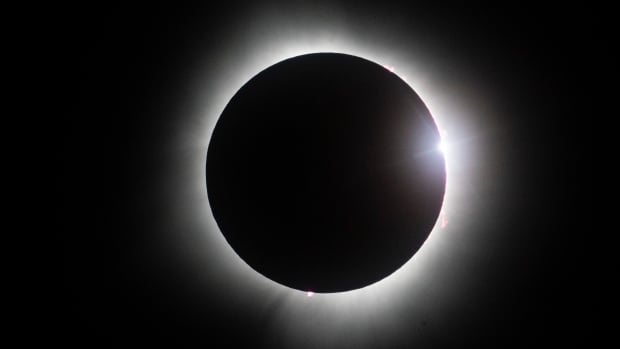Thousands of people flocked to parts of Eastern Canada and the United States this week to catch a glimpse of Monday’s total solar eclipse, when the moon completely blocked out the sun.
For 11-year-old Julian Falkin, who traveled with his family from Vancouver to Cleveland, Ohio, to view the event, it was well worth the trip.
“It was more bright and beautiful than any photo,” he said.
“I think I’ve seen a partial eclipse before but it was nothing like this.”
So when will it be B.C.’s turn to experience a totality?
Falkin will be 31 by the time it happens, and he’ll still have to leave Vancouver to see the full thing.
A total solar eclipse darkened the skies and wowed onlookers in parts of the country — but if you didn’t get a chance to see it yourself, you can relive the best moments from the celestial phenomenon.
The next solar eclipse anywhere will be on Aug. 12, 2026; but will be only partly visible in North America, with totality instead crossing over parts of Europe. The totality of another one will graze Northern Canada in 2033.
But it won’t be until 2044, 20 years from now, when a path of totality will travel over northeastern B.C. and Alberta.
Here’s what you need to know.
2033: Total eclipse in Alaska, partial in B.C.
Because they are astronomical events, researchers are able to tell when eclipses will happen far into the future.
Ingrid Stairs, a professor of physics and astronomy at UBC, says the best places to research upcoming events are on NASA’s future eclipses page and a similar entry on Wikipeda, plus the timanddate.com eclipse page which shows when they will be visible in specific cities.
On March 30, 2033 a total solar eclipse pass over the Bering Strait, portions of eastern Russia and the westernmost part of Alaska, including the communities of Nome in the south and Utqiaġvik (formerly known as Barrow) in the north.
The sun will start being blocked at 8:57 a.m. local time in Nome and 9:04 a.m. in Utqiaġvik, with the totality lasting about two minutes and 30 seconds, depending on the exact location.

Getting there will take planning. Most communities in the region are only accessible by air or sea and lodging is limited, something worth considering given the number of visitors who showed up in Niagara Falls, Ont., ahead of Monday’s eclipse.
The 2033 eclipse will be partially visible in much of B.C., including Vancouver, where more than half the sun will be blocked at 10:41 a.m. PT, and in the northern half of the province, where it will be reduced to a crescent.
2044: Total eclipse in eastern B.C., Alberta
The next one to pass over the mainland United States and Canada will be Aug. 22, 2044. That evening the totality will pass over Fort Nelson, Dawson Creek and Golden, B.C., and, in Alberta, over Grande Prairie, Calgary, Edmonton, Banff and Lethbridge before moving on to Montana and North and South Dakota.
But the rest of B.C. won’t miss much — the sun will almost entirely be blocked out in the rest of the province, as well, with just a tiny sliver visible from Prince Rupert to Vancouver Island.
Grade 5 student Julian Falkin travelled from Vancouver to Cleveland, Ohio, to view Monday’s total solar eclipse first-hand. He spoke to BC Today host Michelle Eliot, alongside his dad, Aaron Malkin.









